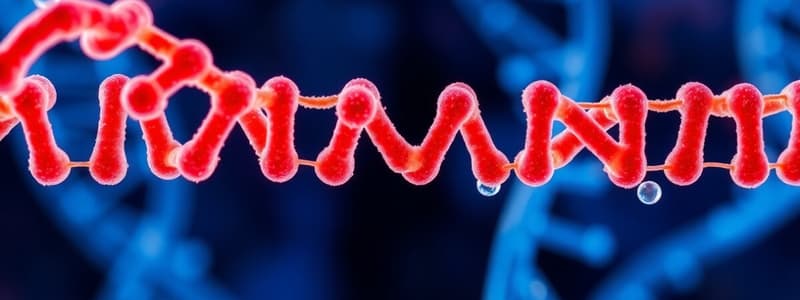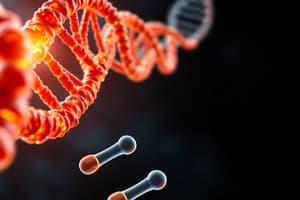Podcast
Questions and Answers
What role does DNA ligase play in the repair process?
What role does DNA ligase play in the repair process?
- It seals the gap left by the removed dimer. (correct)
- It activates photolyase.
- It removes nucleotides associated with the dimer.
- It cleaves the dimer structure.
Which enzyme is responsible for the cleavage of the cyclobutane ring in thymine dimers during photoreactivation?
Which enzyme is responsible for the cleavage of the cyclobutane ring in thymine dimers during photoreactivation?
- Endonuclease
- Exonuclease
- DNA polymerase
- Photolyase (correct)
What type of light is absorbed by photolyase in the repair of thymine dimers?
What type of light is absorbed by photolyase in the repair of thymine dimers?
- Blue light (correct)
- Green light
- Ultraviolet light
- Red light
In the excision repair pathway, which enzyme removes several nucleotides including the dimer?
In the excision repair pathway, which enzyme removes several nucleotides including the dimer?
What happens to the DNA strand after photolyase cleaves the dimer?
What happens to the DNA strand after photolyase cleaves the dimer?
Which process occurs during the SOS repair mechanism when a thymine dimer is present?
Which process occurs during the SOS repair mechanism when a thymine dimer is present?
During post-replication recombination repair, what occurs when there are gaps due to a thymine dimer?
During post-replication recombination repair, what occurs when there are gaps due to a thymine dimer?
What triggers the induction of the SOS system in DNA repair?
What triggers the induction of the SOS system in DNA repair?
What triggers the formation of a thymine dimer in DNA?
What triggers the formation of a thymine dimer in DNA?
Which repair mechanism uses visible light to break apart thymine dimers?
Which repair mechanism uses visible light to break apart thymine dimers?
During nucleotide excision repair, what initially happens to the thymine dimer?
During nucleotide excision repair, what initially happens to the thymine dimer?
What role does DNA polymerase I play in the excision repair process?
What role does DNA polymerase I play in the excision repair process?
What is the primary consequence of a thymine dimer in a DNA double-helix structure?
What is the primary consequence of a thymine dimer in a DNA double-helix structure?
What enzymatic action is performed by photolyase during photoreactivation?
What enzymatic action is performed by photolyase during photoreactivation?
What is the role of the uvr gene in excision repair?
What is the role of the uvr gene in excision repair?
What is an effect of ultraviolet light on thymine monomers within DNA?
What is an effect of ultraviolet light on thymine monomers within DNA?
Flashcards are hidden until you start studying
Study Notes
Thymine Dimers
- Thymine dimers are formed when two adjacent thymine bases in a DNA strand bond together.
- This bonding is caused by ultraviolet (UV) radiation.
- The formation of thymine dimers disrupts the normal structure of DNA, causing a kink in the double helix.
Repairing Thymine Dimers
- Two main processes are involved in repairing thymine dimers: Nucleotide excision repair and photoreactivation.
Nucleotide Excision Repair
- This process involves the removal of the damaged section of DNA containing the thymine dimer and replacing it with new nucleotides.
- Steps involve:
- Recognition of the dimer by enzymes.
- Cutting the DNA strand on both sides of the dimer.
- Removal of the damaged section.
- Filling in the gap with new nucleotides.
- Rejoining the strand.
Photoreactivation
- This process uses visible light to directly break apart the thymine dimer bond.
- This is a simpler repair process compared to nucleotide excision repair.
- Requires the photolyase enzyme which binds to the dimer and absorbs blue light to break apart the dimer bond.
Photoactivation for Repair of Thymine Dimer
- Photolyase is an enzyme that uses blue light to break apart thymine dimers.
- This process is referred to as photoreactivation.
Cleavage of Thymine Dimer Crosslinks by Photoreactivation
- Photolyase binds to the thymine dimer in a DNA strand.
- Photolyase absorbs blue light, which activates the enzyme to break the dimer bond.
- After the dimer is removed, photolyase detaches from the DNA strand.
Diagram of the Excision Repair Pathway
- Excision repair involves a series of enzymes that remove the damaged section of DNA containing a thymine dimer.
- Steps include:
- Cutting of the DNA strand on either side of the dimer by endonuclease enzymes.
- Removal of the damaged section, including the dimer, by exonuclease enzymes.
- Filling in the gap with new nucleotides by DNA polymerase.
- Sealing the gap by DNA ligase.
Simplified version of Postreplication Recombination Repair
- This repair process utilizes sister chromosomes to fill in gaps left in DNA replication due to the presence of a thymine dimer.
- Recombination occurs between the damaged strand and its sister chromosome, resulting in one chromosome with the dimer and one without it.
SOS Repair
- This repair process is a last resort used when DNA damage is extensive.
- It involves an error-prone replication process that bypasses the thymine dimer, allowing replication to continue.
- While this allows for replication, it may introduce mutations, as the dimer is not actually removed.
Studying That Suits You
Use AI to generate personalized quizzes and flashcards to suit your learning preferences.



